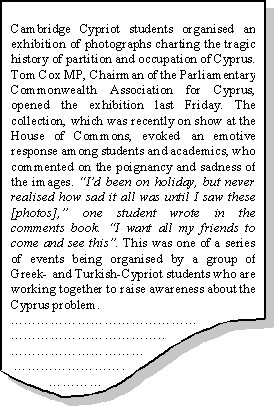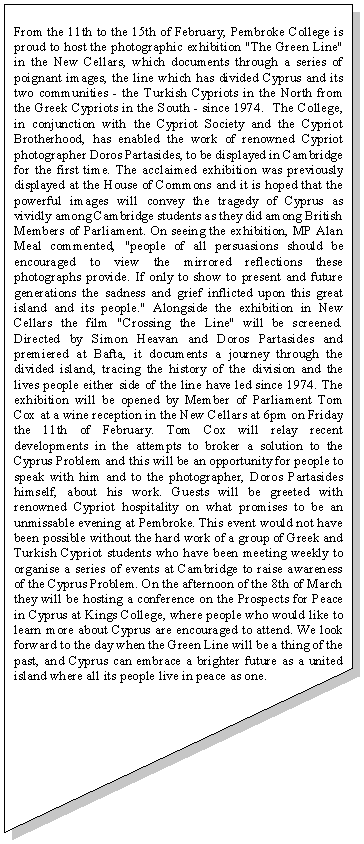| EVENTS:
| exhibition | CUSU motion | conference
| 'espresso' |
 The
Green Line - Divided Cyprus
The
Green Line - Divided Cyprus
by Doros
Partasides
11th
- 15th February 2000
New Cellars, Pembroke College
Barbed wire has been
extensively used in Cyprus since at least the 1950's, when the
colonial government locked roads in order to try and contain Greek
Cypriots demonstrating for union of the island with Greece. It seems
that by that time nationalism had taken hold of both Greek- and
Turkish-Cypriot communities and in a sense, barbed wiring was only the
end of the beginning. As a resolution to the competing requests of the
Greek-Cypriots for union with what they considered their
motherland Greece and of the Turkish-Cypriots for division of
the island into two states, Britain, Greece and Turkey proposed
independence of the of the Cypriot State under an unwilling
partnership of the two communities. The agreements were signed in
1960.
By 1963 the first
inter-communal clashes had occurred and UN soldiers were sent to
protect civilians from hostilities; meanwhile the Royal Green Jackets,
forming a Constabulary Force, laid barbed wire. A number of
Turkish-Cypriots died in a series of highly publicised murders,
especially in 1963-64 and 1967-68. As a result, the majority of the
Turkish-Cypriot community was forced into enclaves under
Turkish-Cypriot administration. Greek-Cypriot police heavily guarded
the borders of these enclaves and access to the outside was greatly
restricted.
The Green line came into
existence in this period and has divided Cyprus into north and south
sectors ever since. Plans on how these sectors should be organised in
terms of Turkish- or Greek-Cypriot administration were still being
discussed when a coup d'etat took place, instigated by an extreme
right-wing paramilitary group of Greek-Cypriots (1974). Turkey sent
troops as an intervening power but refused to withdraw them when the
Greek-Cypriot leader was restored to power. They took control of the
north part of the island that borders on the Green Line. The great
majority of Greek-Cypriots who lived in this area fled and were
re-settled in the south as refugees. The Turkish-Cypriots who lived in
the south emigrated to the northern part within the next few weeks,
and thus the Green Line has come to mark the division between the
island's largest ethnic groups.
The UN mandate for
stationing troops to the island has continued to be extended at
regular intervals to the present day, due to the inconclusive dialogue
between the two communities for a mutually acceptable solution. UN
troops are the only inhabitants of the Green Line - crossing is
extremely difficult as the Green Line marks the 1974 line of
cease-fire (and therefore also referred to as the 'Neutral' or 'Dead
Zone'). For many Greek-Cypriots it represents the inaccessibility of
lost homes and property and for many Turkish-Cypriots it represents
the guarantee of a life in safety. For other Greek- and Turkish-
Cypriots it represents the failure of the international and
local communities to provide a viable strategy for co-existence over
the most part of the last century.
:: article taken from Varsity
student newspaper:

:: article taken from
Pembroke magazine:
